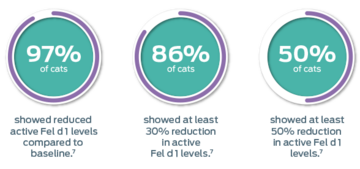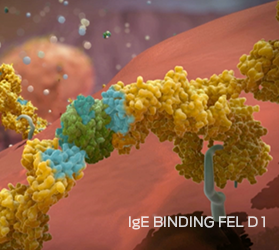The Breakthrough


“Most methods for managing these allergens focus on limiting or avoiding exposure to cats or treating the symptoms. Our discovery, however, has the potential to prevent the allergic response from taking place. This study is a significant milestone and may be able to transform how people manage their cat allergies.”
Dr. Ebenezer Satyaraj, Director of Molecular Nutrition at Purina and lead investigator on the research
Purina's research

Purina scientists discovered that an egg product ingredient containing IgY antibodies to Fel d 1, the major cat allergen, can bind to Fel d 1 in the cat’s saliva, preventing its ability to trigger an allergic response in a cat allergen-sensitized individual.
Watch the video to see the mode of action behind this discovery.
Anti-Fel d 1 IgY are naturally produced by chickens who share their environment with cats (e.g., farms with chickens and free-roaming cats) and transferred to their eggs.
Egg-based IgY ingredients have been used safely in human and veterinary medicine.1-4 The egg product ingredient containing anti-Fel d 1 IgY is safe for cats, based on a comprehensive safety study that fed an egg product ingredient with multiple levels of anti-Fel d 1 IgY, including levels many times higher than those used in our efficacy studies.5
This approach maintains normal allergen production by the cat, without affecting the cat’s overall physiology.
Transformational Results


A new approach for reducing Fel d 1 allergen load takes advantage of the antibody-allergen interaction to neutralize Fel d 1 after its production by the cat but before it spreads to the environment. A diet with an egg product ingredient containing anti-Fel d 1 IgY was fed to cats, resulting in significant decreases in active Fel d 1 (Fel d 1 that is capable of binding to IgE and triggering an allergic response in sensitized individuals) in the cats’ saliva and on their hair.6,7

When cats were fed a diet with the egg product ingredient containing anti-Fel d 1 IgY, the levels of active Fel d 1 in their saliva were significantly reduced within 3 weeks.6 The diet with the egg product ingredient also significantly reduced active Fel d 1 on the cat’s hair: 97% of the cats had a decrease in active Fel d 1 levels, with an average reduction of 47% starting in Week 3.7
One-half of the cats had at least a 50% reduction in active Fel d 1 levels on their hair, and 86% of cats had a reduction of at least 30% from baseline levels.7
A reduction in active Fel d 1 in the cats’ saliva and on their hair will ultimately reduce active Fel d 1 in the environment, which may help reduce symptoms in allergic people.7,8
This discovery could transform how people manage allergies to cats, ultimately bringing cats and people closer together.
Learn more about our breakthrough discovery
Related content
Find out more about this discovery, and what this could mean for the lives of cats and the people who care for them:
Find out more
- Karlsson, M., Kollberg, H. & Larsson, A. (2004). Chicken IgY: utilizing the evolutionary difference. World’s Poultry Science Journal, 60, 341-348. doi: 10.1079/WPS200422
- Nguyen, S.V., Umeda, K., Yoyokama, H,, Tohya, Y. & Kodama, Y. (2006). Passive protection of dogs against clinical disease due to Canine parvovirus-2 by specific antibody from chicken egg yolk. The Canadian Journal of Veterinary Research, 70, 62-64.
- Rahman, S., Nguyen S.V., Icatlo, F.C., Umeda, K. & Kodama Y. (2013). Oral passive IgY-based immunotherapeutics. Human Vaccines & Immunotherapeutics, 9, 1039-1048. doi: 10.4161/hv.23383
- Schade, R., Calzado, E.G., Sarmiento, R., Chacana, P.A., Porankiewics-Asplund, J., Terzolo, H.R., (2005). Chicken egg yolk antibodies (IgY-technology): A review of progress in production and use in research and human and veterinary medicine. Alternatives to Laboratory Animals, 33(2),129-154.
- Matulka, R. A., Thompson, L. & Corley, D. Evaluation of a multi-level safety study of anti-Fel d 1 IgY. Forthcoming, 2019.
- Satyaraj, E., Li, Q., Sun, P. & Sherrill, S. Anti-Fel d 1 immunoglobulin Y antibody-containing egg ingredient lowers allergen levels in cat saliva. Submitted, Journal of Feline Medicine and Surgery.
- Satyaraj, E., Gardner, C., Filipi, I., Cramer, K. & Sherrill, S. (2019). Reduction of active Fel d 1 from cats using an antiFel d 1 egg IgY antibody. Immunity, Inflammation & Disease. Advance online publication. doi: 10.1002/iid3.244
- Wedner, H.J., Mantia, T., Satyaraj, E., Gardner, C., Al-Hammadi, N. & Sherrill, S. Feeding cats egg product with anti-Fel d 1 antibodies decreases environmental Fel d 1 and allergic response. Manuscript in preparation.



